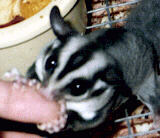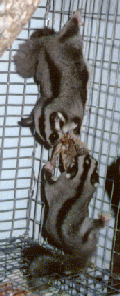|
Diet
NOTE: there are new changes to my Leadbeater's Mix recipe AGAIN; please take a look! Originally, I based my diet on the Taronga diet, which was sent to me by an Australian researcher and former employee of the Taronga zoo in Sydney, Australia. It's a great diet, just not always practical for American pet owners to try and reproduce! I've also learned things over the years that I didn't know in the beginning. I do give my gliders some yogurt now. I've learned that gliders can tolerate a certain amount of lactose, contrary to information I was sent when I first had gliders. I also didn't realize at that time that the lactose in yogurt is broken down more readily because of the bacteria cultures it also contains. My older gliders get yogurt occasionally, but babies get it every day because of the beneficial bacteria cultures it contains, not to mention calcium. The 4 most important things to remember in choosing a diet for your gliders are:
I've seen gliders described as insectivores, because in the wild they eat insects, insect larvae, and spiders. But that's not entirely accurate, because they also eat eucalyptus sap, acacia gum, nectar and pollen, manna (sap that oozes from wounds on trees), and honeydew (a sweet substance excreted by sapsucking insects). But they're not strictly nectar eaters either, because they also eat bird eggs, birds, lizards, and other small animals. So it's most accurate to say that sugar gliders are omnivores. During the spring and summer months their diet consists almost entirely of insects, providing them the increased protein needed for reproduction. I had a breeder friend back when gliders were still relatively new on the scene, who had a beautiful aviary that housed a colony of gliders. Since the gliders stayed mostly in the top areas of the aviary, she thought it would be appealing to have little button quail living in the bottom. That's how I first found out that gliders ate birds... The colony had a great feast, and got to keep their aviary to themselves after that! ProteinProtein is an important part of any glider's diet, but is especially important to breeding-age females. Over the years I've experimented with a lot of ways to get protein into my gliders' diet. The Taronga diet calls for day-old chicks, but that's a bit macabre for most pet owners (myself included). Day-old chicks conjure up images of Easter bunnies and little girls in frilly dresses, and the memory of my Grandma's kitchen. (She had this coffee pot that sat in the corner, and when her chickens abandoned eggs that were late to hatch she would tuck them into a Kleenex box padded with crumpled tissues and put them behind the coffee pot where they would stay warm. When the chicks hatched, I got a front-row seat at the kitchen counter. So chicks are NOT an option!)
Now, however, I have moved too far north for Junebugs, and living in the city I can't take the chance that any grasshoppers I might find (they're also not that plentiful here, but I'm not complaining!) haven't been contaminated by pesticides. I now raise mealworms and crickets for my gliders; both are also readily available at just about any pet store, for those with smaller numbers of gliders to feed. Boiled eggs are a good source of protein, because the protein they contain is almost completely usable by the body. This is not the case with many protein-containing foods. However, there is a tradeoff; they are high in phosphorus, which inhibits the absorption of calcium. I also feed my gliders ground turkey (simmered with water) several times per week, and use a monkey diet that contains 25% protein as the base for all of their meals. The turkey also has a bad calcium/phosphorus ratio, so extra calcium is needed to balance it out. WaterAn ample supply of fresh water is very important. Gliders dehydrate and die quickly when they don't have enough water. I use only filtered water for my gliders and my birds, and I add 1/4 cup of organic apple cider to each gallon. Apple cider vinegar is a natural antibiotic and is very beneficial, not only to animals but to people as well. You CAN overdose it, though, so more isn't better. When buying apple cider vinegar, be sure and only buy the kind that has sediment at the bottom - they call it the "veil of the mother" -- that's the good stuff. :) CalciumI can't emphasize enough the importance of calcium. Glider bones quickly lose mass when their diet doesn't contain enough calcium, and become fragile and easily broken. I lost my first male to hind leg paralysis only a few days after I got him, so even though I'm not sure it was due to calcium deficiency, I'm still pretty paranoid about calcium. Phosphorus inhibits the absorption of calcium, and many of the items we feed our gliders have high phosphorus to calcium ratios. Because of this it is very important to supplement calcium in their diets, being sure to use a calcium supplement that doesn't contain phosphorus. T-Rex makes one for reptiles called 2:0, and Rep-Cal is also a good one to use. In many animals, overdosing calcium can cause urinary tract problems, but so far I have not heard of a necropsied glider showing any evidence of over-calcification. However, the opposite is true in a majority of cases. So I'm pretty liberal with the calcium, especially on nights when I feed items that I know have high phosphorus levels. Fats and SweetsGliders have a real sweet tooth, and can be little pigs when it comes to sweets and fatty foods. My first pair of gliders were not tame, so when I discovered foods they particularly liked, I'd use them as bribes to get them to trust me. Pecans were a favorite, as were sugar cubes. I had enough sense not to give them much sugar, but pecans seemed safe enough... Within a few months I had two gliders who were very tame, and also very very FAT. Many pet stores make the mistake of advising their customers to feed gliders parrot seed mixes. This is totally wrong, don't do it! If having a plump glider doesn't bother you, there are other things to consider. Fatty deposits can build up in the eyes, causing blindness. And gliders fed an improper diet can develop very strong smelling urine. Has anyone told you gliders make bad pets because they smell bad? They've been around gliders whose diets were not correct. I've found three common causes for smelly gliders:
The third case I've only seen once. At first I was mystified, because the person who e-mailed me with the problem listed the diet their glider was getting, and it was great. They weren't using vitamin supplements, so I couldn't blame that. Further investigation, however, revealed that the glider was apparently a bit of a glutton, and was eating at least twice as much as a normal glider eats every night. Her owner cut back on her feeding amounts, and the smell went away. I have recently changed my stance (again) on vitamins. This is a continual learning process, and because of that my diet is in a constant state of change as I learn more about the needs of sugar gliders. I now recommend Rep-Cal's Herptivite.
My DietSo, with all that said, here's how I feed my gliders. There are two staple items that my gliders get every night:
Other foods they get include:
Baby foods are also good, if you only have a few gliders -- fruits, sweet vegetables, and vegetable/meat mixtures are all well-received, as are the little "junior" hotdog-looking things they make for babies who are beginning to eat finger foods. The monkey biscuits I use are Lab Diet 5045 Monkey Diet. I buy them in 25-pound bags, and don't know for sure if they are available in smaller sizes. They can be ordered through feed stores at reasonable prices. If kept for long periods of time, I would store them in the freezer to keep them from losing their nutritional value. If you can't find the Lab Diet biscuits, both ZuPreem and Kellogg's also make good monkey diets, and they can be ordered from sources such as Exotics Central or Hornbeck's. I keep dry monkey biscuits in my glider cages all the time, but for their nightly feedings I use them moistened, because the gliders get more of the nutritional value that way. When they eat dry foods, gliders chew, suck and spit, resulting in the little leftover food pellets that used to mystify me. But when the food is moistened, they swallow more of it and therefore take in more of its nutrient value. About every third night I feed a "meat and veggies" meal. The rest of the time I give them mostly fruits with their meal. Here are a couple of typical menus, with portions appropriate for two adult gliders:
"Extras" I might add vary from night to night depending on what's in season and what I have on hand. Fruit flavored yogurt (not non-fat, and with live cultures), applesauce, and various fruit or sweet vegetable baby foods are always well-received. Just about any kind of fruit will be eagerly devoured, although they do have their own individual likes and dislikes. Gliders are funny about food; one day they'll devour something eagerly and the next day they won't touch it. Sometimes a food they've turned their nose up at in the past will suddenly become a favorite. They each have their own personality and tastes, and you'll just have to work at learning what they like. Young gliders can be especially difficult; they tend to be very picky about what they will eat. If you keep offering them a variety of foods though, they will eventually learn to broaden their horizons. Don't cater to their whims, and don't be afraid to waste food. When I serve kiwi, everybody gets some, even the ones I know don't like it. Every once in a while they surprise me and actually eat it. If you don't offer them a variety, whether they seem to always eat it or not, you can lock them into very narrow eating patterns, making it difficult to get a balanced diet into them in the future!
Some "tricks" I use that might make things easier (several of these were passed on to me by other breeders, and some I actually thought of myself):
| ||||||||||||||||||


